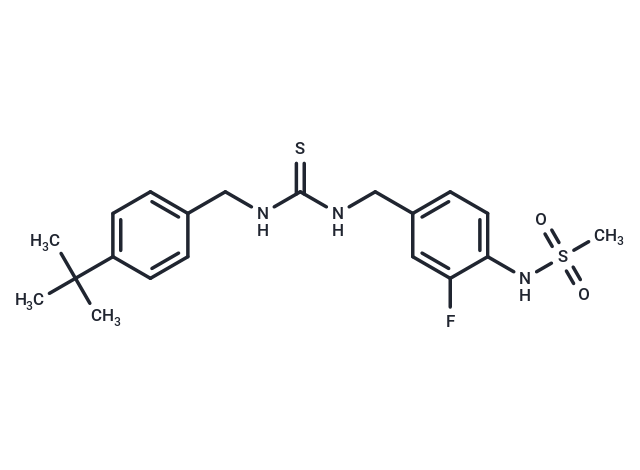Shopping Cart
- Remove All
 Your shopping cart is currently empty
Your shopping cart is currently empty

JYL 1421 (SC 0030) is an antagonist of TRPV1 receptor (IC50 = 8 nM).

| Pack Size | Price | Availability | Quantity |
|---|---|---|---|
| 1 mg | $64 | In Stock | |
| 5 mg | $197 | In Stock | |
| 10 mg | $322 | In Stock | |
| 25 mg | $645 | In Stock | |
| 50 mg | $987 | In Stock | |
| 100 mg | $1,570 | In Stock | |
| 200 mg | $2,090 | In Stock | |
| 1 mL x 10 mM (in DMSO) | $183 | In Stock |
| Description | JYL 1421 (SC 0030) is an antagonist of TRPV1 receptor (IC50 = 8 nM). |
| Targets&IC50 | TRPV1:8 nM |
| In vitro | JYL 1421(5 min) inhibits the capsaicin (330 nM)-evoked Ca2+ accumulation in a concentration-dependent manner. The inhibitory effect of the lowest concentration (5 nM) of JYL 1421 reaches the level of significance and 1 μM almost abolishes the response, only 3.1±0.65% of the first capsaicin-induced Ca2+ influx could be observed[1]. |
| In vivo | Intravenous capsaicin injection at 1 and 2 μg/kg causes a temporary blood pressure drop of 47.4±4.7 and 59.6±4.2 mmHg (n=6), respectively. JYL 1421 at 0.4 and 1.6 mg/kg does not induce hypotension but inhibits the capsaicin-induced blood pressure drop in a dose-dependent manner, necessitating higher capsaicin doses to trigger reflex hypotension post-administration. Capsazepine up to 2 mg/kg does not significantly inhibit capsaicin-evoked hypotension. Capsaicin solution (50 μL, 10 μg/mL) instilled into the left eye of rats causes 12.9±1.3 wiping movements within 3 minutes. Pretreatment with JYL 1421 (0.4 or 1 mg/kg i.p.) does not significantly affect wiping behavior, but doses of 2-5 mg/kg reduce the movements dose-dependently with an ID50 value of 4.6 mg/kg. The mean arterial pressure of untreated rats is 109.9±4.2 mmHg (n=6)[1]. |
| Alias | SC 0030 |
| Molecular Weight | 423.57 |
| Formula | C20H26FN3O2S2 |
| Cas No. | 401907-26-4 |
| Smiles | CC(C)(C)c1ccc(CNC(=S)NCc2ccc(NS(C)(=O)=O)c(F)c2)cc1 |
| Relative Density. | no data available |
| Storage | keep away from direct sunlight,store at low temperature | Powder: -20°C for 3 years | In solvent: -80°C for 1 year | Shipping with blue ice. |

Copyright © 2015-2025 TargetMol Chemicals Inc. All Rights Reserved.